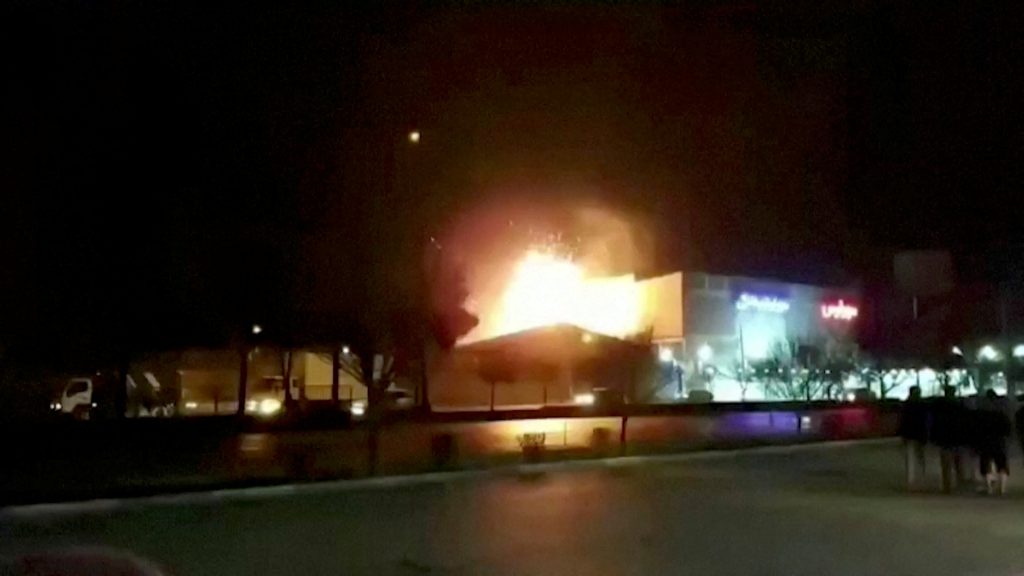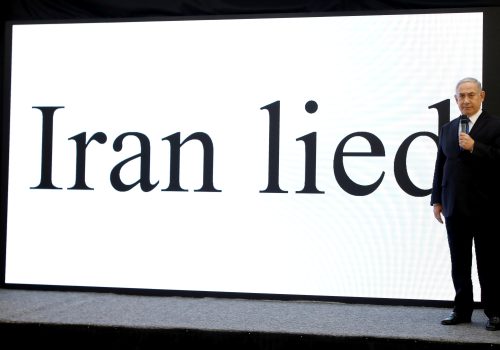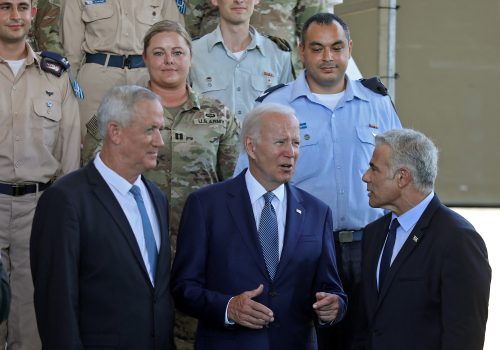Drones attacked a military facility in the Iranian city of Isfahan on Saturday, a strike that US officials reportedly are attributing to Israel. While the details remain unclear around the exact nature and effectiveness of the strike, the geopolitical ramifications are fast becoming clear. We turned to our experts on Iran, Israel, and the region to help explain the dynamics at play—and what’s coming next.
Click to jump to an expert reaction:
Daniel B. Shapiro: The US needs a post-JCPOA Iran strategy, coordinated with Israel
Holly Dagres: An embarrassment for Iran’s security apparatus
Thomas S. Warrick: Israel seems to be sending a message. Will the US follow?
The US needs a post-JCPOA Iran strategy, coordinated with Israel
The apparent Israeli strikes on Iranian military facilities, and the hurried clarifications from US officials that they were indeed Israeli-authored, suggest that US-Israeli coordination on an Iran strategy following the abandoned nuclear agreement known as the Joint Comprehensive Plan of Action (JCPOA) remains a work in progress.
The chances of a return to the nuclear deal are now vanishingly small, Iran having rejected multiple opportunities to conclude such an agreement. Tehran’s brutal repression of anti-regime protesters and its military aid to Russia for its war in Ukraine only further weaken the viability of any resumption of the JCPOA.
But in the meantime, Iran has advanced its nuclear program to threshold status, with enough highly enriched uranium (if further enriched to weapons-grade) to build multiple nuclear bombs. While evidence has not emerged of a regenerated weaponization program, it most certainly cannot be ruled out.
The situation calls for a revised US strategy, coordinated to the maximum degree possible with Israel and other regional partners. Deterrence must be one of its key elements. The massive joint exercise conducted by the US and Israeli militaries last week, Juniper Oak 23, was a huge step forward in that strategy. With long-range bombers, precision targeting, and mid-air refueling all part of the drill, it was clear that offensive capabilities relevant to Iran, and not merely a defense of Israel, were being rehearsed. The exercise was actively messaged as such on all social media channels.
But this excellent US-Israel coordination may not have extended to the strikes in Iran over the weekend. Israel does not always inform the United States about such operations in advance, and US leaders (civilian and military) seek to avoid being implicated in attacks they did not conduct, so as not to draw an Iranian response. The Biden administration has shown great understanding of Israel’s need to project force against Iran and appreciation for the benefits of such strikes. Improved coordination of messaging about them would serve both US and Israeli interests and strengthen the effectiveness of deterrence.
—Daniel Shapiro is a distinguished fellow at the Atlantic Council’s Middle East Programs and former US ambassador to Israel.
An embarrassment for Iran’s security apparatus
The talks to revive the Iran nuclear deal have been dead since September 2022. Twenty-seven cameras monitoring Iran’s nuclear sites have been shut off, and the country has enriched seventy kilograms of uranium at 60 percent purity. Last week, the director general of the International Atomic Energy Agency said that Iran has “enough nuclear material for several nuclear weapons,” though it hasn’t developed one. It’s in this atmosphere that a drone strike was reportedly carried out by Israel on a munitions factory in the central city of Isfahan, next to a facility associated with Iran’s ballistic missile program.
If the reports are accurate, this is the first action against Iran taken by the far-right Benjamin Netanyahu government and, in essence, appears to be Israel sending a message and possibly “mowing the lawn” to slow down Iran’s unchecked capabilities (we don’t have enough details about the facility to know for sure).
This drone strike is yet another great embarrassment for the security apparatus of the Islamic Republic and demonstrates its incompetence—it cannot protect its facilities but can gun down and beat to death seventy-one children during ongoing protests.
Though there’s not enough information about how much damage was done to the site, it’s clear the Islamic Republic is trying to save face by downplaying the incident and damage by even making fun of the drone’s (in)capabilities. This doesn’t mean that the Islamic Republic will take this event lightly, however. Expect Iran to hit back somehow—but at this stage it’s impossible to tell when or how.
—Holly Dagres is a nonresident senior fellow at the Middle East Programs and editor of IranSource.
Israel seems to be sending a message. Will the US follow?
The strike, reportedly by Israel, on Saturday in Isfahan was aimed not just at disrupting an Iranian military facility. Israel appears to have used a tactic—quadcopter drones—that it has used before but that are typically short-range. This sends Iranian security forces the humbling reminder that the strike may have been launched from inside Iran itself. As with other targeted operations Israel has conducted in recent years, Israel appears to want to show that it has the ability and the daring to carry out attacks aimed at preventing either nuclear or conventional threats to Israel’s security.
The apparent Israeli strike is also a reminder to the United States, whose secretary of state arrived in Israel on Monday, of the need for more effective US action to disrupt Iran’s nuclear and missile programs, both of which together threaten not just Israel but a number of Arab Middle Eastern allies of the United States. US President Joe Biden has made it very clear that he will not allow Iran to acquire a nuclear capability, and the stalled Iran nuclear talks mean that Israel wants to remind Biden that he may need to back up his threat. US military capabilities to disrupt Iran’s nuclear and missile program obviously go far beyond anything Israeli quadcopters may have done thus far.
—Thomas S. Warrick is a nonresident senior fellow in the Scowcroft Center for Strategy and Security’s Forward Defense practice and a former deputy assistant secretary for counterterrorism policy at the US Department of Homeland Security.
Further reading
Fri, Jan 27, 2023
What will it take to deter Iran from targeting opponents inside the US?
New Atlanticist By
The US Department of Justice unsealed charges Friday in an alleged assassination plot directed by Iran against a US journalist. Our experts unpack the ongoing threat.
Thu, Jan 19, 2023
Netanyahu’s Iran policy is expected to fail—again
IranSource By Danny Citrinowicz
The biggest problem that Israeli Prime Minister Benjamin Netanyahu has today is the fact that he will have a tough time rallying the Joe Biden administration.
Tue, Oct 4, 2022
Iran’s new demands to revive the nuclear deal are a sigh of relief for Israel. Here’s why.
MENASource By
Israel knows very well that Iranian demands are impossible to meet.
Image: Eyewitness footage shows what is said to be the moment of an explosion at a military industry factory in Isfahan, Iran, January 29, 2023, in this still image obtained from a video. Pool via WANA (West Asia News Agency) via REUTERS



